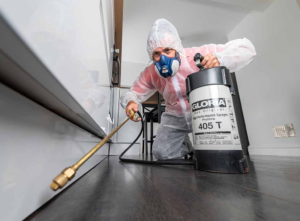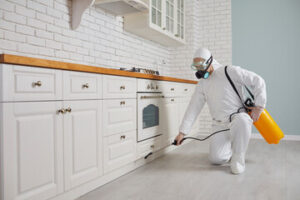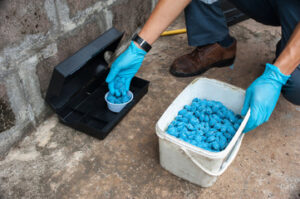Springfield MO Pest Control is focused on diminishing losses caused by vermin. It includes prevention, suppression, and eradication.
Use pesticides sparingly. Only licensed workers wearing protective clothing and equipment should apply them. Thoroughly read the label and follow all safety warnings and instructions. Keep children and pets out of areas where they are being treated. Remove sources of food and shelter for pests, such as rubbish bins that are not tightly closed or flies’ favorite roosting places.

Pests are more than annoying—they can also carry disease, cause allergic reactions, and damage your home or property. Preventing pests is the best option for pest control, and the first step is to identify the problem and understand what causes it.
The simplest prevention technique is to eliminate the food source that attracts the pest. For example, keep garbage cans tightly closed and clean, and dispose of waste properly. Inside, store foods in sealed containers. Keep counters clear, and sweep and mop regularly. Clutter provides hiding places for insects and rodents, so get rid of it.
Other preventive techniques include monitoring and scouting. For example, noticing a few wasps or bees at a time is unlikely to warrant action, but seeing them every day indicates that you have a nest somewhere nearby that needs to be located and removed. Threshold-based decision making focuses on identifying the pest’s environment and using physical, biological and chemical techniques to manage it at the right level of intervention – avoiding harming beneficial organisms, people or property.
Mechanical or physical controls can help to reduce the attraction of pests, including screens, barriers and traps. Some specialized tools can even alter the environment to suppress pests, for example by changing the amount of sunlight or water available, or by adding heat or cold to an area.
Biodiversity can also contribute to preventive pest control by enhancing or creating habitats that are less attractive to certain pests. In agriculture, this may involve planting more species of plants to provide different types of food or cover. In other situations, the benefits of biodiversity may be more subtle – for example, by providing habitat for predators or parasites that reduce pest populations.
Eradication is rarely the goal for outdoor pests, except in areas where a foreign, unwanted plant is established. But it is sometimes the goal in indoor environments, such as in homes and commercial kitchens, where pests can pose serious health and safety risks. For example, roaches and other pests can contaminate food with bacteria, viruses and other pathogens.
Suppression
Pest control involves removing or inhibiting the growth of unwanted organisms to a level that is acceptable. Generally, there are three methods of treatment: prevention, suppression, and eradication. Preventive treatments prevent pest infestations from developing or worsening, such as by blocking their access to food, water, shelter and space. This may include pest proofing a home or garden by building barriers to entry, regularly cleaning garbage, and storing food in sealed containers. It also includes removing any nests. This is sometimes combined with a regular program of inspection and treatment by a professional, such as using traps or bait stations for rodents and insects, or applying sprays of horticultural oils, fungicides or insecticidal products.
Once a pest has established itself, control techniques usually focus on either suppressing the population or removing it entirely. Eradication is rarely used in outdoor situations, but is occasionally attempted when a specific pest is known to present a threat to health, safety or property (e.g. Mediterranean fruit fly or gypsy moth). In enclosed areas, such as homes, schools, hospitals and offices, eradication is more common.
Suppression tactics often work in tandem with prevention strategies, since they help to reduce the size of pest populations before they can cause unacceptable damage. These may include environmental controls such as climate or topography that limit the number of pests by restricting their environment, biological controls such as natural enemies or predatory species that injure or consume pests to manage their numbers, and cultural practices such as modifying land use or introducing plants that are naturally resistant to certain pests.
Once these steps are taken, it is important to monitor and assess the success of any suppression tactic. This allows for appropriate adjustments in prevention and avoidance tactics and can identify the conditions that led to the pest problem in the first place. In addition, monitoring can indicate when eradication is required, or when a different approach to pest control might be more effective. This is especially true for sporadic or migratory pests that are difficult to predict. This type of monitoring is called scouting or inspection and can be done manually or with the aid of electronic pest management systems.
Eradication
Even with the best preventative measures, pests can still make their way into buildings in large numbers. This is considered an infestation, and can have serious health implications for building occupants, as well as having a negative impact on the environment. Pest control is normally performed by a professional and licensed pest control technician.
Some pests can be controlled by physical barriers and traps. For instance, rodents can enter a building through the smallest cracks and holes, so sealing these is one of the most effective ways to deter them. Trimming trees and bushes away from a building can also be helpful, as pests can use branches as bridges to enter. Keeping garbage cans sealed and stored away from the building is another simple yet effective pest deterrent.
In some cases, chemical pesticides are used to kill pests. These are typically poisonous and are meant to specifically target and kill the pests that are causing an issue. They come in the form of sprays and granules and should only be used by professionals with the proper training and licensing. Ideally, a pesticide should be paired with other methods of pest control in an integrated pest management approach to ensure maximum effectiveness and safety for both workers and customers.
While it is possible for individuals to carry out their own pest control, most commercial properties will use qualified and authorised professional pest controllers. These may be local council pest controllers or one of the 878 professional commercial pest control services companies operating throughout the UK.
The most important thing to remember about eradication is that it is a process that takes time and patience. It can take years to eradicate a particular pest species, especially if it is an invasive or infectious disease. For example, the WHO has been working on an eradication program for the guinea worm (Dracunculiasis) since 1960.
There are many reasons why it is not appropriate to use eradication techniques in all situations. For instance, some pests are vital parts of our natural ecosystems, and eliminating them would have a serious impact on the environment. In addition, the elimination of some pests can be dangerous to human beings, especially if they are infectious. This is why a lot of eradication programs focus on controlling pest populations and limiting their impacts, rather than eliminating them entirely.
Biological Control
The biological control of pests, or biocontrol, is the use of predators and parasitoids of insects or pathogens of plants (diseases) to reduce their numbers. This is a natural method of controlling pests that can be used alone or in combination with other methods such as suppression and eradication. Biological control techniques can be applied in home landscapes and commercial agriculture or in greenhouses. Biological control agents are living organisms with their own needs and so require special consideration in use. To be effective, the organisms must be able to find their prey and survive in the environment. Some biological control agents have specific requirements, such as the need for a certain type of soil or temperature.
There are three major approaches to biological control: conservation, augmentation and importation. In the home landscape, conservation is the principal practice followed. The goal of this practice is to promote and enhance natural enemies already present in the landscape. This is usually done by changing landscape management practices to make the environment more attractive to the natural enemy species. It can also be accomplished by providing habitat useful to the natural enemy, for example planting flowers that attract caterpillar-eating wasps or plants that provide food to frogs that paralyze caterpillars.
In the case of augmented biological control, organisms are purchased and released in large enough numbers to overwhelm or suppress pest populations. This method is best used when the existing population of natural enemies is insufficient to keep pest populations under control. Because biological control agents are living organisms, they need to be carefully selected and released to ensure that they are well adapted to their new environments.
Many biological control agents are host-specific, meaning that they only kill or parasitize a single type of insect. To be successful, the agent must be able to reproduce at a high rate and survive in the new environment. For example, fungi are often used for biological control of insects because they germinate on the cuticle of the insect and form structures that penetrate the insect. However, a wide variety of fungi are available for this purpose, and so the identification of the insect species to be controlled is critical in order to purchase the correct fungus.




